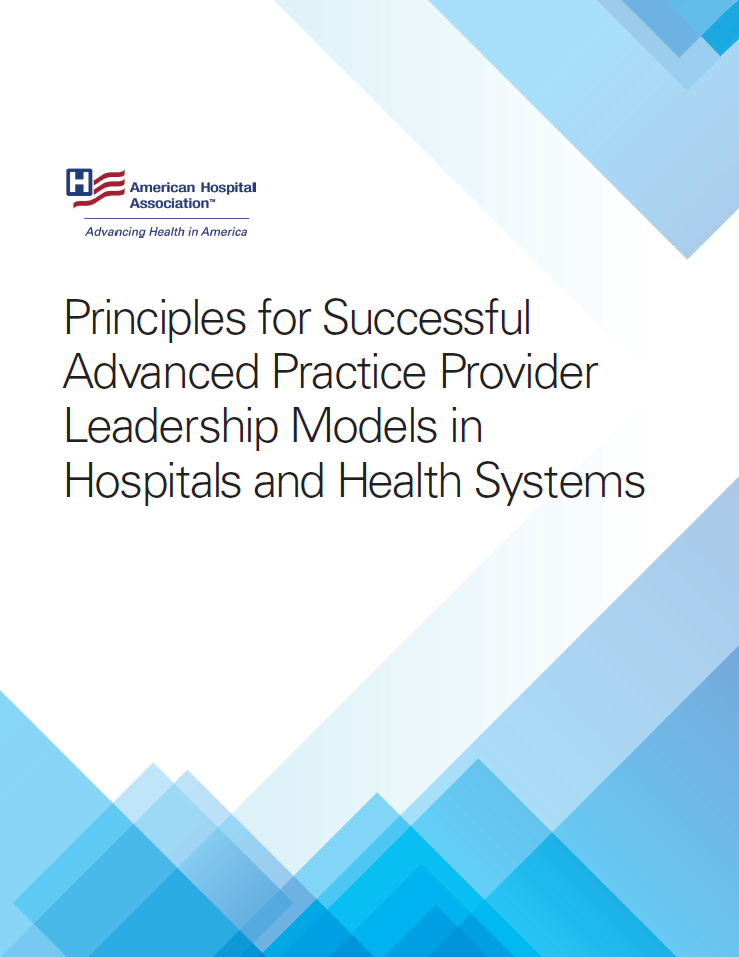Principles for Successful Advanced Practice Provider Leadership Models in Hospitals and Health Systems
The Advanced Practice Provider (APP) Leadership Advisory Group began as a grassroots conversation — APPs and AHA representatives recognizing that traditional physician and nurse leadership models often don’t capture the unique scope and strategic potential of APP roles. They quickly saw an opportunity to address a gap in the field and support a large, growing segment of the workforce more effectively. Read more about how these principles were developed.
Principles for Successful Advanced Practice Provider Leadership Models in Hospitals and Health Systems
BACKGROUND
WHY: Advanced Practice Professionals (APPs) are increasingly part of the health care team and are providing a significant portion of care within many hospitals and health systems. Their roles and scopes vary across states and locations, but the essential value of their contribution to health care is evident in the rapidly increasing amount of patient care they deliver today. As these professions have evolved, their role within traditional medical staff and nursing structures has created challenges as the roles intersect with both structures but may not fit appropriately in either. As a result, to best support the unique needs of APPs in their ongoing professional development, practice evaluation and strategic value to team-based health care delivery, many organizations have been developing APP leadership structures. Those organizations that have successfully developed APP leadership structures and functions demonstrate cultures of engagement and teamwork leading to increased collaboration and patient-centered care delivery as well as foster greater organizational alignment and operational effectiveness.
Creating this leadership and governance structure will necessarily look different across health care settings, but through the steps below, the value to and from APPs will be enhanced. As part of the clinical team, APPs should be engaged in leading care delivery and the principles outlined below identify key steps at a local level. For larger health systems, regional management approaches should be considered.
WHO: An APP is a health care clinician who has additional graduate level education, training, licensure and certification who can provide health care services authorized and regulated by state law which can include assessment, evaluation, diagnosis, treating and prescribing for patients as defined by their education, training, licensure and certification. Recognizing that in some states others may be included, APP is most commonly used as a collective term referring to physician assistants/associates (PAs) and advanced practice registered nurses (APRNs).1
Foundational Elements
- Educate on the roles, responsibilities and value of the APP community within the health system.
- Identify APP teams and roles across the hospital or system as members of the clinical staff and leadership.
- Articulate the value of APPs to the health care delivery team, their role in revenue generation, the value of integrated, interprofessional care provided by a group with different areas of expertise.
- Articulate the unique needs APPs carry as health care professionals.
- Identify costs, benefits and opportunities gained in the inclusion of APPs in the care delivery team in terms of safety, quality, cost savings, revenue generation, access to care, patient experience and practice effectiveness.
INFRASTRUCTURE SUPPORTS
- Develop an office of advanced practice and/or APP leadership structure to provide strategic workforce planning, and operational accountability for the APP team, led by a c-suite partner who serves as part of the leadership team.
- This structure should include data access and analytic support to manage human resources, financial and quality metrics and strategic planning for the team.
- Where possible and within the regulatory framework of your state and organizational policies, APPs should report to other APPs and into the leadership structure.
- Similarly, where possible, structures for addressing professionalism and peer interventions should be led by APPs for APP colleagues.
- Provide pathways for professional onboarding and ongoing development for the overall continuous improvement of the APP team.
- Provide support from operational teams to APP structure (i.e., marketing, human resources, finance, data analytics, etc.).
- Identify leaders across sites, service lines, or other functional structures to govern and support local engagement with the APP office.
- Develop APP Leadership Council or committee structure to support the leadership including representation from all professions and care delivery settings – identify subcommittees to address quality and safety, practice improvement, employee engagement, etc.
- Embed APPs within hospital leadership committees, i.e., Peer Review, Credentialling, Patient Safety, etc.
- Consider opportunities to include APPs in the medical staff bylaws where appropriate and consistent with state law and regulations.
- Identify and fund APP continuing professional education, development support, and an APP educator.
- Develop engagement metrics and strategies unique to the APP community and monitor accordingly. Identify opportunities for local and health system wide recognition programs for APPs.
KEY ELEMENTS OF THE APP LEADERSHIP ROLE
- The APP leader should have oversight of business development, budget, workforce strategy/ compensation planning, professional development, continuing education, operational management and terminal authority of advanced practice.
- The APP leader should be an executive level position and a partner to the nurse and physician executive leaders within the organization.
- The APP Leader (or designee) should participate in and be a full member of the following committees:
- Credentialing & Privileging
- Compensation
- Bylaws
- Peer Review
- Medical Staff/executive committee (evaluate if membership is an option and update bylaws accordingly)
- The APP leader should be adaptable and innovative, understanding local needs while maintaining patient-focused care and quality outcomes.
- The APP leader should work with colleagues to understand and comply with state and federal practice laws and regulation while ensuring internal policies provide appropriate role scope.
1 State laws will influence the structures and forms this work can take given differences in scope of practice.


